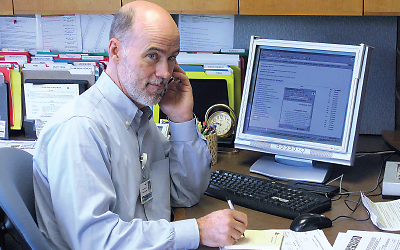Like many psychiatrists in community mental health, John Kern, M.D., heard an alarm bell in the night when Joseph Parks, M.D., chief clinical director in the Missouri Department of Mental Health, published his data in 2006 demonstrating the high rate of premature death among people with serious mental illness.
Those data showed that people with serious mental illness were dying on average 25 years earlier than the general population—largely because of complications related to general medical conditions, especially metabolic syndrome. “Those were our patients he was talking about,” Kern said.
As the director of Regional Community Mental Health Center in Merrillville, Ind., Kern had spent the previous 20 years doing the familiar tasks of a community mental health center (CMHC) medical director—supervising psychiatrists, providing direct care, and overseeing an inpatient unit—and he was unacquainted (at that point) with the work of Jürgen Unützer, M.D., and the growing movement toward collaborative care.
But in the past seven years, Kern has become a true believer and one of a growing cadre of psychiatrists dedicated to the integration of primary care and psychiatric services for people with serious mental illness in the community. Today, he is working with his staff toward establishing the CMHC as an “FQHC-look-alike” (a special designation of federally qualified health center) with on-site primary care and a range of ancillary services—smoking-cessation classes and diet, nutrition and exercise counseling.
He is project director for a primary and behavioral health care initiative (PBHCI) at the CMHC, funded with a grant from the Substance Abuse and Mental Health Services Administration that provides support to communities to coordinate and integrate primary care services in publicly funded, community-based behavioral health settings. And he acts as the “face” of integrated care—to the CMHC board, fellow physicians in the community, and patients and the public.
Kern told Psychiatric News he believes other psychiatrists need to seize this moment of health care reform. “I think psychiatrists need to lead the way,” he said. “When you are director of a CMHC, there is always plenty to do, always lots of things to fill up your day. And you can do that and keep doing things the way we’ve been doing them for a long time, and the moment will pass us by.”
Building the Plane While Flying It
The path Kern has followed in the last six years is a case example of how psychiatrists can seize the moment: learn the models of integrated care, network with other physicians in the community, make yourself available to primary care physicians, build relationships, and become a leader.
“I started calling around to the local primary care doctors in the community,” he recalled. “There was a nearby FQHC [federally qualified health center], and I picked up the phone and called the CEO and said, “Would you be willing to see our CMHC patients?’ She said, ‘Sure, the more the merrier.’
“Then she said, ‘By the way, are you a psychiatrist?’ I said yes, and she said, ‘Would you come over—like right now?’ ”
‘I Became a Part of This Community...’
So began, in 2007, a partnership with the local FQHC providing behavioral health services at two primary care sites. Later, Kern applied for and was accepted into a “learning collaborative” sponsored by the National Council for Community Behavioral Health where he met Unützer and other leaders. “I became a part of this community of psychiatrists interested in expanding integrated care.”
Out of that experience, Kern adopted the collaborative care model developed by Unützer and others at the University of Washington, with an “embedded” mental health consultant at the two FQHC sites.
So what does this mean for Kern’s day-to-day practice? “I take phone calls through the workday from the behavioral health consultant and occasionally from PCPs about clinical issues as they arise,” Kern explained. “I visit the FQHC sites, talk to the PCPs, and supervise the behavioral health consultants, including talking about difficult cases, reviewing registry of ongoing cases, talking about systems issues and refining our model of care. I provide clinical training to the PCP provider staff on behavioral health issues, such as appropriate prescribing practices for controlled substances, the care of bipolar disorder, ADHD, use of meds in pregnancy and the perinatal period, and management of patients with traumatic brain injury. I also work with the FQHC administration on matters related to billing and improving clinical procedures connected to the behavioral health services.
“I’m still a CMHC director with all of those duties,” he said. “All of my work with the FQHC is done in about 10 percent of my time.”
Kern said it has been an experience of “trying to build the plane while flying it” with some lessons learned along the way. And all of this is happening in the context of a larger payment system that is still in flux. “One of the challenges is that the system is still fluid,” he said. “Many of the things we are excited about doing in integrated care depend on a global payment system. Right now if a patient comes to us and gets integrated primary care instead of going to the emergency department all the time, that’s saving someone money—but it’s not us, and we don’t get any credit for it. In a global payment system like the VA or an accountable care organization, you can see the cost savings, and we believe it has real potential to bend the cost curve.”
Kern has advice for other psychiatrists he’s learned while traveling his long, slightly winding road. “You need to lead the way,” he said. Recalling, for instance, when he learned of the opportunity to apply for the PBHCI grant, he realized he would have to write the thing—or no one would. “We didn’t have anybody to write grants. I was a CMHC medical director; I didn’t write grants. But I realized this was crucial, and if the medical director doesn’t step up and write the grant, this program would never happen.
“As psychiatrists, we need to get on board, because this integrated care movement is our best opportunity in decades to make our work more interesting and effective and to help our patients more than we have been able to do.” ■

